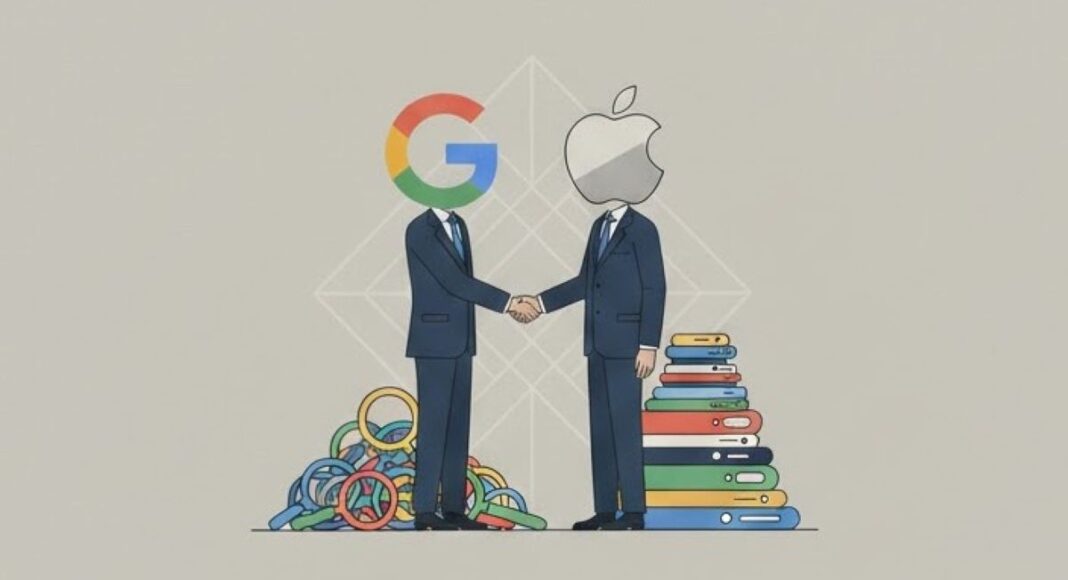The Google Search monopoly case focused on how Google’s agreements with Apple to set Google Search as the exclusive default search engine on Apple’s mobile devices allowed Google to solidify its monopoly in internet search. However, a less-explored dimension of these agreements is how they likewise fortified Apple’s monopoly power in the smartphone market, writes Steven C. Salop.
Google’s agreement with Apple to share a portion of the advertisement revenue it makes through its search engine in return for default status on Apple’s devices was a key element in the U.S. v Google internet search monopolization case. This agreement has had the anticompetitive effect of deterring Apple from sponsoring a rival search engine or entering the search market itself. However, there is another potential anticompetitive effect of the agreement. The agreement reduced Google’s incentive to engage in conduct to drive competition between its mobile operating system, Android, and the mobile phones reliant on it, and Apple mobile phones, which use Apple’s proprietary iOS operating system. Google’s reduced competitive incentive helps to maintain Apple’s monopoly power in mobile handsets and devices, which the U.S. Department of Justice is preparing to litigate in another case, U.S. v Apple. This is because the agreement acts as a facilitating device in the mobile handset and internet search markets.
The government’s complaint in U.S. v Apple does not include this allegation that Apple’s search advertising agreement with Google helps to maintain Apple’s monopoly power. The government might add this arrow to its litigation quiver in U.S. v Apple for several reasons. First, it further supports the claim that Apple has monopoly power. Second, it adds to Apple’s list of anticompetitive conduct, which then can support a stronger remedy. Third, and perhaps most significant, it provides a rationale for prohibiting all revenue-sharing between Apple and Google, not just the prohibition of exclusive revenue-sharing that Judge Amit Mehta mandated in Google Search. In this regard, Judge Mehta’s concern that prohibiting rent-sharing would lead to higher handset prices, presuming that Google’s payments to Apple have subsidized prices for consumers, leaves out the important impact of the revenue-sharing agreement on competition between Apple and Google in the mobile handset market.
The analysis of the Google/Apple agreement in Google Search focused on the effect of Google’s revenue-sharing payment to Apple on the search advertising market, a payment which amounted to about $20 billion 2022. The government alleged that this payment reduced Apple’s incentive to enter the search advertising market. But that is not the end of the story. The $20 billion payment was reported to be about 36% of the total search advertising revenue Google earned through Google searches on Apple’s Safari browser. That means that Google retained the remaining 64% of the advertising revenue. Since it already obtains a substantial share of the advertising revenues, its incentive to have Android licensees, like Samsung, obtain a higher share of mobile device users is reduced accordingly.
Suppose that, absent the agreement, Apple had partnered with another search engine or entered the market itself. Furthermore, suppose that Google would have obtained 20% of searches on Safari and would have retained 100% of the search advertising revenue on these searches. In this but-for world, if an Android licensee obtained a marginal user instead of Apple, and Google obtained 100% of this marginal search revenue, the revenue difference between revenue earned through the additional Android user versus the additional Apple user would be 80%.
By contrast, as a result of the agreement in which Google retains 64% of the search revenue from searches through Apple Safari, an additional Android user only represents a revenue difference of 36%. This 44% differential (i.e., 80%-36%) in the revenue capture rates affects Google’s competitive incentives. By reducing the gains from capturing users from Apple, Google’s incentives to drive competition between Android and Apple devices is reduced. And this reduced incentive helps maintain Apple’s monopoly power in mobile handsets and devices. Thus, Judge Mehta’s concern that prohibiting rent-sharing would lead to higher handset prices leaves out the important impact of the revenue-sharing on competition between Apple and Google. By supporting Apple’s alleged monopoly in handsets, the agreement may very well raise prices for consumers by more than Google’s revenue-sharing payments reduce them.
Google’s share of the advertising search revenue on Apple devices might be conceptualized and further quantified “as if” Google has financial interest in Apple devices. Apple’s gross income was about $171 billion in 2022, which includes the $20 billion payment from Google. If the $20 billion payment is 36% of the search advertising revenue that Google earns through Apple Safari, then total revenues are about $56 billion, of which Google retains $36 billion (i.e., $56 billion-$20 billion). This means that the $36 billion that Google earns through Apple mobile devices but keeps represents about 17% of the profits Apple generates on its devices ($36 billion/($36 billion + $171 billion). Framed in this way, the revenue-sharing agreement might be analogized to Google having a 17% passive ownership interest in Apple. And it may not be totally passive. By controlling the links to search queries and search ads, Google can affect Apple’s revenue and product quality.
However, whether or not this ownership interest would be found to violate Section 7 of the Clayton Act on its own is not the relevant question in the U.S. v Apple case. Instead, it is relevant as additional conduct that contributes to Apple’s monopoly power. As such, it is part of the “monopoly broth” at issue in the case.
Of course, the fact that Apple’s competitive incentives are also reduced as a result of its advertising revenue-sharing agreement with Google should not be ignored. These two anticompetitive impacts of the search advertising agreement reinforce one another. The benefits of the agreement to Apple of reducing Google’s incentive to compete in the smartphone market is a type of quid-pro-quo for Apple’s reduced incentives to compete in the search advertising market. In this sense, the Google/Apple search advertising agreement is a two-edged type of a collusive mutual competition-disincentive facilitating device. It not only disincentivizes Apple from competing in the search advertising market. It also disincentivizes Google from competing for Apple iPhone users.
The Google Search remedy prohibits Google’s exclusive revenue-agreements. However, even though exclusive agreements are prohibited, the same (or at least very similar) effects can be obtained through non-exclusive or even unconditional revenue-sharing agreements which are permitted by the court’s remedy. In a recent article, Erik Hovenkamp and Doug Melamed explained that the remedy would seem to permit Google and Apple to have an agreement whereby Apple still makes the Google search engine the default for 99% of the searches.
I have also explained that similar anticompetitive results occur if the remedy permits Google to share search advertising revenue, even absent a condition making Google Search the default choice. Making unconditional payments for searches voluntarily directed to Google’s search engine create the same disincentives for Apple to compete in search and for Google to compete for mobile handset users. If Google is permitted to offer search distributors (i.e. internet browsers) a revenue share for every search query voluntarily directed to Google Search, Apple will still be incentivized to make Google the default. They will continue to earn a revenue-sharing payment for exclusion. The asymmetric incentives in the Gilbert and Newbery model still apply. The only difference is that now they will be paid on a query-by-query basis rather than all-or-nothing. This also creates an impediment to a rival’s attempts to gain search distribution by counterbidding for search opportunities.
Finally, if the government does add this allegation to its lawsuit against Apple, I can imagine Apple replying that the antitrust laws do not prohibit a monopolist from selling its product at any non-predatory (i.e., above-cost) price. In this matter, Google actually is a buyer that is purchasing distribution services from Apple and others. But in any event, the Leegin resale price maintenance (RPM) decision provides the rebuttal to this possible Apple claim. Leegin explains that RPM “can be abused by a powerful manufacturer. […] A manufacturer with market power […] might use resale price maintenance to give retailers an incentive not to sell the products of smaller rivals or new entrants.” The possible exclusionary effects of RPM at the manufacturer level are explained by John Asker and Heski Bar-Isaac. The economics of the way RPM by a dominant manufacturer can deter retailers from selling the products of new entrants is exactly the same mechanism as Google’s revenue-sharing. In essence, Google sets the retail price of advertising charged to the advertisers and shares part of its revenue with Apple and the other retail distributors of internet search through which consumers access digital advertising. Thus, its revenue-sharing agreements can violate the antitrust law under the rule of reason.
Author Disclosure: Steve Salop is Professor of Economics and Law Emeritus, Georgetown University Law Center and Senior Consultant, Charles River Associates.
Articles represent the opinions of their writers, not necessarily those of the University of Chicago, the Booth School of Business, or its faculty.
Subscribe here for ProMarket’s weekly newsletter, Special Interest, to stay up to date on ProMarket’s coverage of the political economy and other content from the Stigler Center.






